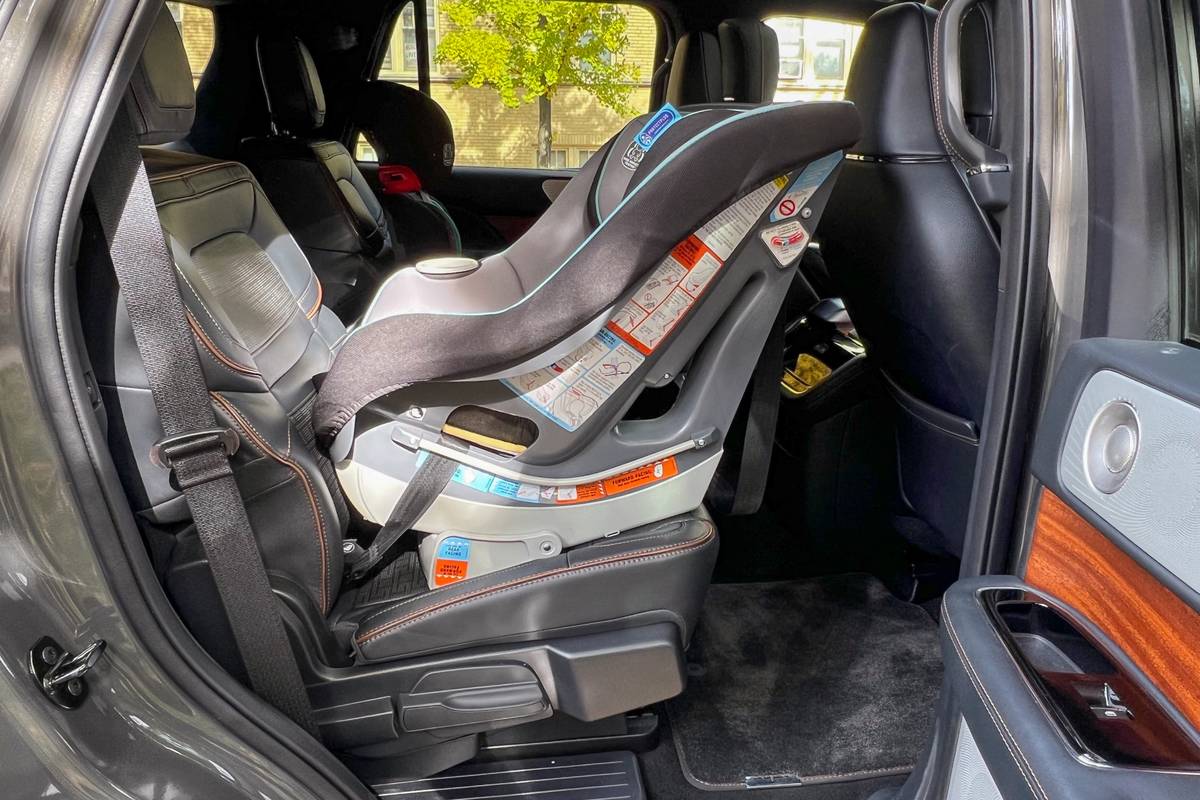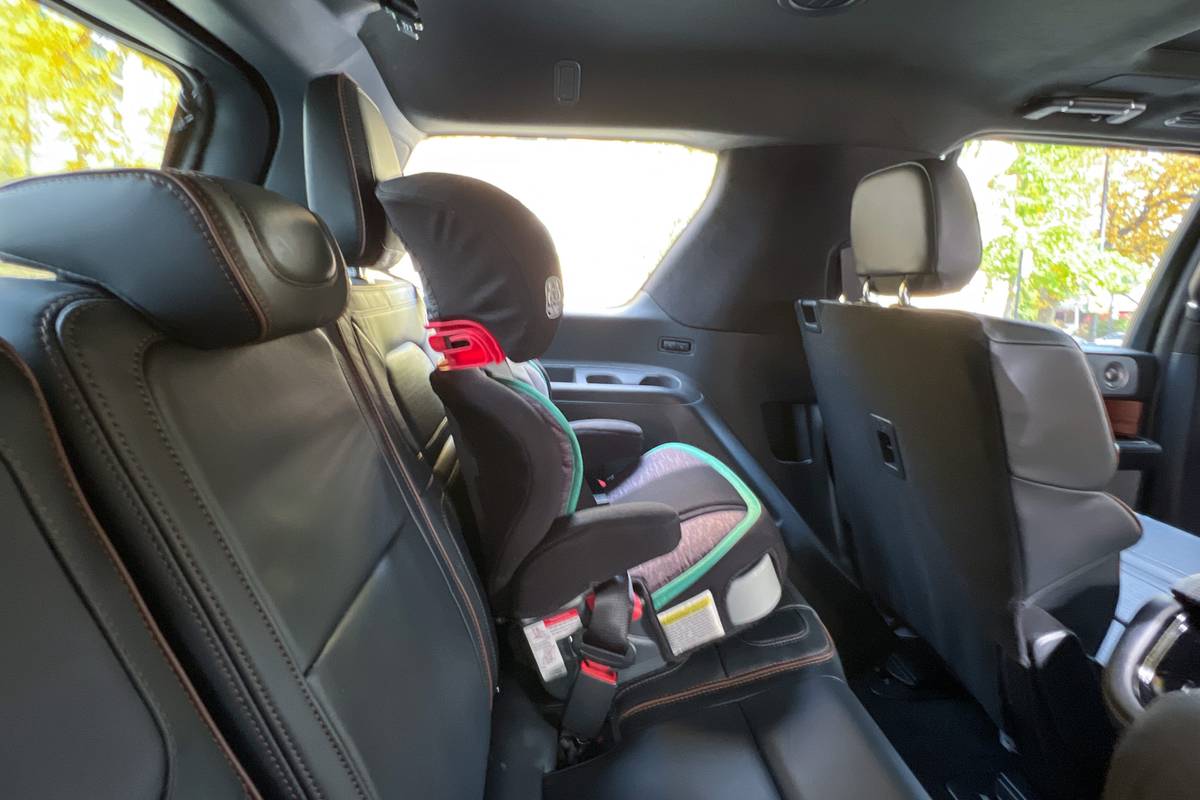How Do Car Seats Fit in a 2023 Lincoln Navigator?


Editor’s note: This Car Seat Check was published in November 2022 about the 2022 Lincoln Navigator; little has changed with the 2023 model. See what’s new for 2023 or check out a side-by-side comparison of the model years.
The verdict: Lightly refreshed for 2022, the Lincoln Navigator is packed with updates, including tweaked exterior styling, a new adaptive suspension with a road-preview function that mitigates bumps and Lincoln’s ActiveGlide hands-free driving system. We tested a Navigator in the top Black Label trim with second-row captain’s chairs and a three-seat bench in the third row.
Does it fit three car seats? No.
Take a look at how the Latch system and each car seat scored below in our Car Seat Check of the 2022 Lincoln Navigator.
Related: Search Car Seat Checks

A Grade
- Latch: In the second row, the captain’s chairs each have a set of lower Latch anchors. The lower anchors are a bit crowded by the seat cushions, but surprisingly, we didn’t have any issues using them with the car seats’ connectors. The chairs’ top tether anchors sit midway down the seatback, and they were a snap to use.
- Latch, third row: The Navigator has two sets of lower Latch anchors in the outboard seats as well as three top tether anchors on the third-row seatbacks. All the anchors were easy to find and use, with no connection issues.
- Infant seat: The Navigator’s roomy second row had plenty of space for this rear-facing car seat. The infant seat’s installation was drama-free.
- Rear-facing convertible: Installation of this rear-facing car seat was quick and easy, thanks to the second row’s spaciousness.
- Forward-facing convertible: In the second row, the forward-facing convertible fit well. The second row’s head restraints are removable, allowing for a tighter connection to the top tether anchor.
- Third-row access: With the push of a button, the captain’s chairs tilt and slide forward to create a large pathway to the third-row seats. The step-in height is manageable for little ones thanks to the power running boards.

B Grade
- Booster seat: The second row’s wide captain’s chairs easily handled our high-back booster seat. However, the seat belt buckles sit low, making them tough to grasp. The Navigator tries to minimize the difficulty by lighting the buckle receptor, which is a thoughtful addition.
- Forward-facing convertible, third row: The third row’s fixed head restraints didn’t interfere with our forward convertible fit when the car seat’s adjustable back is in its lowest position, but it will interfere once expanded.
C Grade
- Booster seat, third row: The third-row seat’s fixed head restraints interfered with the high-back booster seat’s fit, preventing the booster’s seatback from resting firmly on the Navigator’s seat. A backless booster seat would likely work better for this seating position. There are two styles of seat belt buckles in the third row: On the driver’s side, the buckle lays flat in the seat cushion rather than on a stable base. We tested this version and didn’t have any major issues connecting to the buckle. The other buckles are on stable bases but sit low in the seat cushions, so they may be tough for small hands to find and grasp.
Grading Scale
A: Plenty of room for the car seat and the child; doesn’t impact driver or front-passenger legroom. Easy to find and connect to Latch and tether anchors. No fit issues involving head restraint or seat contouring. Easy access to the third row.
B: One room, fit or connection issue. Some problems accessing the third row when available.
C: Marginal room plus one fit or connection issue. Difficult to access the third row when available.
D: Insufficient room, plus multiple fit or connection issues.
F: Does not fit or is unsafe.
About Cars.com’s Car Seat Checks
Editors Jennifer Geiger and Jennifer Newman are certified child safety seat installation technicians.
For the Car Seat Check, we use a Chicco KeyFit 30 infant-safety seat, a Graco Contender 65 convertible seat and Graco TurboBooster seat. The front seats are adjusted for a 6-foot driver and a shorter passenger. The three child seats are installed in the second row. The booster seat sits behind the driver’s seat, and the infant and convertible seats are installed behind the front passenger seat.
We also install the forward-facing convertible in the second row’s middle seat with the booster and infant seat in the outboard seats to see if three car seats will fit; a child sitting in the booster seat must be able to reach the seat belt buckle. If there’s a third row, we install the booster seat and a forward-facing convertible. Learn more about how we conduct our Car Seat Checks.
Parents should also remember that they can use the Latch system or a seat belt to install a car seat, and that Latch anchors have a weight limit of 65 pounds, including the weight of the child and the weight of the seat itself.
Cars.com’s Editorial department is your source for automotive news and reviews. In line with Cars.com’s long-standing ethics policy, editors and reviewers don’t accept gifts or free trips from automakers. The Editorial department is independent of Cars.com’s advertising, sales and sponsored content departments.

Editor-in-Chief Jennifer Newman is a journalist with more than 25 years of experience, including 15 years as an automotive journalist at Cars.com. Jennifer leads the Editorial team in its mission of helping car shoppers find the vehicle that best fits their life. A mom of two, she’s graduated from kids in car seats to teens behind the steering wheel. She’s also a certified car-seat technician with more than 12 years of experience, as well as member of the World Car Jury, Automotive Press Association and Midwest Automotive Media Association. LinkedIn: https://www.linkedin.com/in/jennilnewman/ Instagram: @jennilnewman
Featured stories




